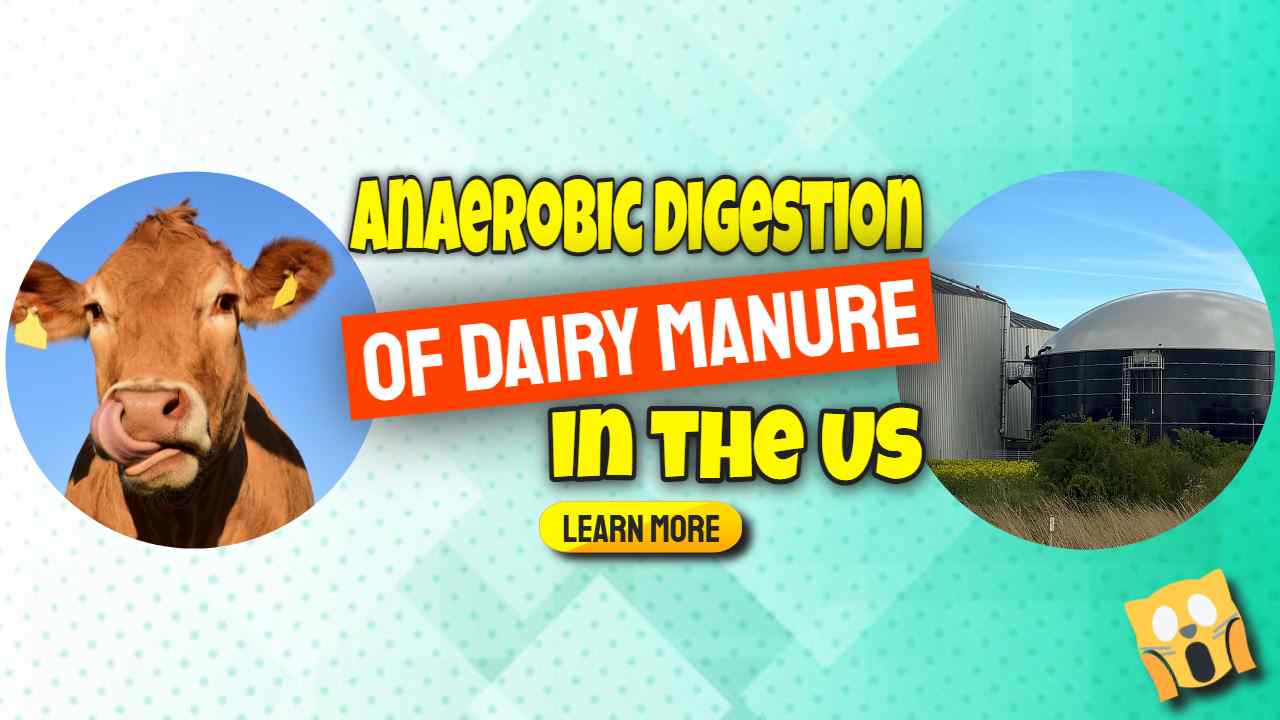The anaerobic digestion of dairy manure In the United States is growing fast, so if you are new to the concept of making energy from farm waste, while also creating fertiliser to replenish the soil, read on!
Dairy farms across the United States face a growing challenge – managing cow dung. With tonnes of waste produced daily, finding sustainable solutions is crucial. One effective method stands out: anaerobic digestion.

This process turns dairy manure into biogas, a renewable energy source. It has gained traction thanks to its dual benefit of waste management and energy generation. 2
In 2015 alone, livestock waste contributed to around 10% of all methane emissions in the US. Anaerobic digestion offers a promising solution by converting this problem into an opportunity for green energy production. 3 Our article explores how this technology tackles environmental concerns and supports farming communities by creating additional revenue streams from what was once considered mere waste.
Read on to discover the potential of anaerobic digestion… 1
Anaerobic Digestion of Dairy Farm Manure – Key Takeaways
- The United States dairy industry is turning cow dung into clean energy through anaerobic digestion. This method creates biogas, cutting farm pollution and greenhouse gases.
- Investments in biogas projects hit $1.8 billion last year (2023), with 96 new setups bringing the country's total to 2,251 active anaerobic digesters.
- Government policies and initiatives, including those by the Biden Administration, encourage using dairy waste for green energy. This helps reduce CO2 emissions significantly each year.
- Anaerobic digestion produces renewable energy and supports rural economies by providing farmers with extra income from waste materials.
- Despite its benefits, challenges like managing large amounts of manure and ensuring economic viability for farmers exist. New technologies hope to overcome these obstacles for wider adoption of anaerobic digestion.
Expansion of Anaerobic Digestion for Dairy Manure in the US
In the USA, more farms now use special tanks to break down cow waste without air every year and each year the number of new biogas plants added gets bigger. This process makes gas we can use for energy and helps cut down farm pollution.

Demand Growth for Biogas from Renewable Sources
People want more clean energy and biogas from dairy farms is getting popular. The United States saw an impressive $1.8 billion investment in new biogas projects last year. 1 This shows that lots of people are interested in making energy from manure.
With 96 new biogas setups starting in 2023, there are now 2,251 active projects around the country. Clean Energy Fuels Corp even built a big $42 million facility at Marshall Ridge Dairy in Iowa to turn manure into renewable natural gas.
This move to using cow waste for power helps the planet and makes good use of what farms already have plenty of – manure! 2
Government Policies Enhancing Anaerobic Digestion
Government support plays a huge role in making anaerobic digestion more common. Funds from federal, state, or local sources help farms start using this green tech. With 221 active systems and the potential for 2,700 more on dairy farms, the encouragement is clear. 3 The AgSTAR programme stands out as a leader here. It shows how backing can drop financial hurdles and push sustainable actions.
Initiatives by leaders like the Biden Administration focus on clean energy from manure. Such policies cut costs while also boosting farm income by turning waste into power. Next up: what the Biden team did to speed things up with anaerobic digestion. 4
Anaerobic Digestion Initiatives by the Biden Administration
The Biden Administration has set plans in motion to grow anaerobic digestion for managing dairy manure. These strategies aim to boost biogas production from renewable sources, like cow dung.
Current systems cut about 4.29 million metric tons of CO2 emissions yearly. 3 The goal is to have more farms adopt this technology, which could slash an extra 29.9 million metric tons of CO2 annually. 5 This move will reduce greenhouse gas emissions and support sustainable rural economies by making farming more eco-friendly and profitable.
Partnerships are key for these initiatives to work well. By working together, dairy farms can link up with energy firms and local governments, creating dependable markets for biogas energy.
This collaboration will help lower costs and increase project income through incentives like tax credits for renewable energy production and carbon offsets. The focus here is clear: make anaerobic digestion a win-win by fighting climate change while boosting the economy in rural areas. 3
Anaerobic Digestion Process Explained
To make energy from dairy cows' leftovers, we use a cool method called anaerobic digestion. First, we gather all the waste and let it break down without air, which makes gas we can turn into power!

Collection and Fermentation of Dairy Waste
Collection and fermentation of dairy waste turn cow poo into power. This process helps farms cut down on waste and make energy. Here's how it works:
- Farms gather poo from dairy cows using machines. These machines keep the farm clean and collect lots of manure quickly.
- They then place this poo in big tanks or pits called anaerobic digesters. These special tanks don't let air in, which is important for the next step.
- Inside these digesters, tiny living things eat the poo without needing oxygen. As they eat, they make a gas called biogas which is mostly methane.
- Methane is the same gas that we all get from the gas grid, it's also a type of fuel that can make electricity, fuel vehicles, or heat homes and buildings.
- The digestion process also makes a liquid that farms can use as a natural fertiliser. This helps grow plants without chemical fertilisers.
- Throughout this, they carefully check everything to make sure it all works right and stays safe.
In the US, there are 221 systems doing this with cow poo from over 260,000 dairy cows. 3 Some use plug flow digesters at about 91 sites; others use complete mix systems or covered lagoons to manage the manure.
Moving on, let's talk about how turning manure into methane cuts down on harmful gases that warm up our planet. 4
Energy Generation from Methane
Methane from cow manure turns into energy. About 65% of cow poo is methane, a powerful gas. 6 Farms collect this waste and use special tools, called anaerobic digesters, to break it down.
These machines are amazing. They take the methane and make electricity or fuel that can replace diesel in generators. 7
This process only changes 20 to 30% of solids in the manure into biogas, but it's a start. Think of dairy farms producing their own power! This not only cuts carbon emissions but also reduces reliance on traditional fuels.
Biogas from anaerobic digestion offers a greener alternative to fossil fuels.
Now, let's discuss how this affects greenhouse gas emissions…
Impacts on Greenhouse Gas Emissions
Anaerobic digestion (AD) of dairy manure cuts greenhouse gas emissions significantly. AD adoption can slash emissions by 2.45 to 3.52 million metric tonnes of CO2 equivalent each year. 8 This reduction is big news for fighting climate change. At the farm level, using AD technology can lower emissions from manure management by up to 79.8%. 9 Such impressive numbers make clear the vital role of AD in reducing our carbon footprint.
The process deals with organic waste like cattle dung and turns it into renewable energy sources such as biogas and electricity. By doing so, it offers a double win—cleaning up farms while creating greener energy options.
Next up, we'll look at how anaerobic digestion supports sustainable rural economies and boosts farming revenues without harming the planet.
Advantages of Anaerobic Digestion
Anaerobic digestion turns dairy farm waste into power and helps farms make money—good for economies and the planet. Keep reading to find out how!

Supports Sustainable Rural Economies
Biogas energy from dairy farms boosts rural areas. It gives farmers extra money, aside from their usual farm work. This helps small towns grow and keeps jobs close to home. Cow manure turns into heat and food for plants, making farming better for the environment. 10
The process makes sure farms can keep running without hurting the land. By using this method, farms cut down on waste and make something useful out of it—energy. This supports local businesses that build and look after these systems, creating more opportunities for people in the countryside. 11
Boosts Traditional Farming Revenues
Supporting sustainable rural economies brings us to how anaerobic digestion directly enhances traditional farming revenues. Farms using AD technology turn waste into an asset, creating biogas and electricity for sale.
This process manages manure and generates a new income stream. For instance, digesters process dairy cow manure to reduce greenhouse gas emissions by about 4.29 MMTCO2e annually in the US alone. 3
Imagine further expansion onto other farms, which could slash another 29.9 MMTCO2e each year, highlighting the crucial role of dependable markets for economic barriers in AD technology's success story.
Anaerobic digestion on farms transforms challenges into opportunities—converting waste into wealth.
Farmers experience significant benefits as they save on energy costs and earn from selling excess power back to the grid or nearby industries needing renewable energy sources. 12 Such operations illustrate a powerful example of turning environmental stewardship into profitable ventures that ensure long-term sustainability for traditional farming practices across the United States.
Lowers Environmental Footprint
Anaerobic digestion (AD) turns cattle dung into biogas, a serious game-changer for the environment. 13 This process means less diesel is used. Less diesel equals less pollution. Plus, the end product from AD gives us an almost smell-free liquid that keeps rats and flies away.
We also cut down on greenhouse gases which heat up our planet. 14
Using this method has another plus – it replaces harmful energy sources with clean biogas. Farms can produce their own energy and not rely on dirty fuels. And because we're using what we already have—dairy manure—we make the most of resources without creating more waste or pollution.
It's clear-cut: turning poop into power lowers the environmental footprint big time, proving smart farming helps our planet breathe a bit easier.
Challenges and Prospects in Dairy Manure Digestion
Turning dairy manure into energy is not plain sailing everyone doing it faces “bumps”. Yet, the future shines with promise as new technologies and ideas enter the field.

Management Issues of Dairy Waste
Managing dairy waste presents significant challenges. Farms produce large amounts of manure daily, causing problems in storage and disposal. The direct application of this waste to land or treatment in two-pond systems is common but not always effective.
These methods can lead to unpleasant odours, the release of ammonia into the air, and increased greenhouse gas emissions. 15
The industry struggles with recycling livestock waste efficiently. Many farms lack access to or cannot afford advanced manure digesters that turn waste into biogas for electricity generation or compressed natural gas.
This financial gap limits their ability to reduce environmental impacts and climate action progress.
Efficient management and recycling of dairy waste are crucial for sustainable farming.
Limited economic viability adds another layer of complexity. Investing in anaerobic digester technology often requires substantial upfront costs, making it less appealing despite its long-term benefits for reducing phosphorus pollution, and water pollution, and contributing to renewable energy production. 16
Next, we explore how limited recycling affects sustainability goals.
Limited Recycling of Livestock Waste
Livestock waste recycling finds few takers. Farms produce tonnes of manure, yet most isn't recycled. This misses chances to cut greenhouse gases and make organic fertiliser. In the US, animal manure accounted for around 10% of methane emissions in 2015. 13 Methane warms the planet much more than carbon dioxide over a short period.
This waste could turn into renewable energy or soil enhancers through anaerobic digestion processes. Yet, barriers exist—costs are high and knowledge is low among farmers. 17 More effective government policies could boost recycling rates by offering incentives or better information on technology like anaerobic lagoons useful in this process.
Next, we explore economic viability concerns within dairy manure digestion efforts…
Economic Viability Concerns
Moving on from the recycling challenges, economic viability is a major concern for anaerobic digestion projects. High fertiliser prices could make digestate more valuable. 18 This might help with costs.
Financial support based on energy production has pushed growth in these projects. Yet, making them pay off remains hard.
Case Studies: Anaerobic Digestion in Action
Real places show us how anaerobic digestion turns dairy waste into energy. These stories prove it works and can help farms and the planet.
Anaerobic Digestion at Lochmead Farms
Lochmead Farms has mastered turning cow poo and barn manure slurries into power. Workers collect waste and ferment it in sealed tanks. 13 This process doesn't just create energy; it also keeps rats and flies away by storing the digester effluent in a covered pit.
The liquid that comes out is well-mixed, making unwanted pests stay clear.
By transforming dairy cattle waste into renewable electricity, Lochmead Farms showcases innovation in tackling the climate crisis.
Each step shows how farms can use what they already have to make something valuable. They're not just dealing with waste; they're producing clean energy and cutting down on greenhouse gas emissions.
This action supports sustainable rural economies by adding an extra source of income for farmers while protecting the environment. 3

The Augean Biogas Project
The Augean Biogas Project makes a big impact by cutting down about 4.29 MMTCO2e of greenhouse gases every year. 3 This is huge for fighting global warming. It uses plug flow digesters to handle waste from over 260,000 dairy cattle across roughly 91 sites.
Essentially, it turns a lot of manure into valuable biogas.
This project shows how we can make energy while also protecting the planet. 20 Next up, let's explore innovative practices at Bakerview EcoDairy.
Innovative Practices at Bakerview EcoDairy
Moving from the Augean Biogas Project, Bakerview EcoDairy stands out with its unique approach to managing dairy farm waste. This farm is special because it manages to cover one-third of its energy needs using a digester and just 50 cows. 13 They have combined this with solar-powered technology and an aquaponic system for raising fish and growing vegetables together.
Bakerview turns manure into power and embraces renewable energy from the sun, making it a leader in sustainable farming practices. Their systems reduce greenhouse gases significantly, proving farms can work hand-in-hand with nature to produce food and energy. 21
Dane County’s Approach to Manure Digestion
Dane County set up its first manure digester in 2011. 13 This system turns dairy waste into something useful. It produces about 16 million kilowatt hours of energy every year. That's enough electricity to power 2,500 homes.
The process helps by cutting down on harmful gases that warm our planet.
This approach shows how farm waste can help make energy and fight climate change at the same time. 3 Next, let's look at other places making a difference with similar systems.
Conclusion to Anaerobic Digestion of Dairy Farm Manure
Anaerobic digestion turns dairy manure into energy and reduces harmful gases. It shows fast growth in the US, driven by policy support and renewable fuel demand. This technology benefits farms economically and lessens environmental harm.
Challenges remain, including managing waste and ensuring economic value. Yet, the rise of biogas from cow poo brings hope for cleaner energy and sustainable farming practices across America.
Anaerobic Digestion of Dairy Farm Manure – FAQs
1. What is the anaerobic digestion of dairy manure?
Anaerobic digestion of dairy manure involves breaking down organic wastes from concentrated animal feeding operations, such as dairies and hog farming, in the absence of oxygen. It's a source of renewable fuel.
2. How does this process impact GHG emissions?
The process helps reduce greenhouse gas (GHG) emissions by converting waste into energy instead of it decomposing in a landfill or composting heap. This can contribute to meeting low carbon fuel standards.
3. Can this method be used for power generation?
Yes, indeed! The biogas produced during anaerobic digestion can be utilised for power generation in utilities – contributing to the energy sector with renewable energy credits.
4. Is there any relationship between dairy farming and factory farming?
Dairy farming often falls under the umbrella term ‘factory farm'. Both involve farmed animals producing large quantities of manure that could potentially cause runoff and environmental damage if not managed properly.
5. Does anaerobic digestion offer any economic benefits for farmers?
Certainly – farmers can monetise their waste by selling carbon offset credits earned through reducing GHG emissions or even use the digestate as fertilisers… a win-win!
6. What role does food waste play in this method?
Food waste can undergo co-digestion with dairy manure – increasing chemical oxygen demand while maintaining an effective C/N ratio… leading to enhanced biogas production.
References
- ^ https://www.linkedin.com/pulse/what-made-2023-third-year-record-growth-us-biogas-industry-serfass-p1fxe
- ^ https://www.ncbi.nlm.nih.gov/pmc/articles/PMC10135913/
- ^ https://www.epa.gov/agstar/anaerobic-digestion-dairy-farms
- ^ https://www.sciencedirect.com/science/article/pii/S0048969719340367
- ^ https://www.epa.gov/system/files/documents/2021-09/anaerobic_digestion_on_dairy_farms.pdf
- ^ https://www.sciencedirect.com/science/article/abs/pii/S0961953416300125
- ^ https://www.epa.gov/agstar/how-does-anaerobic-digestion-work (2024-01-20)
- ^ https://pubs.acs.org/doi/10.1021/acs.est.4c00367
- ^ https://enst.umd.edu/sites/enst.umd.edu/files/files/documents/Extension/Anaerobic-Digest_GHG-Impact_UW.pdf
- ^ https://www.mdpi.com/2071-1050/6/10/6696
- ^ https://www.usda.gov/media/blog/2010/11/18/usda-offers-funding-help-farmers-turn-manure-energy (2010-11-18)
- ^ https://www.epa.gov/agstar/benefits-anaerobic-digestion
- ^ https://blog.anaerobic-digestion.com/anaerobic-digestion-of-dairy-manure-in-the-/ (2021-06-12)
- ^ https://www.sciencedirect.com/science/article/pii/S0301479723022466
- ^ https://onlinelibrary.wiley.com/doi/full/10.1002/cben.202300021
- ^ https://www.sciencedirect.com/science/article/pii/S0301479722027232
- ^ https://www.sciencedirect.com/science/article/abs/pii/S0045653522002922
- ^ https://www.mdpi.com/2227-9717/10/2/212
- ^ https://www.researchgate.net/publication/276099843_Life_Cycle_and_Economic_Assessment_of_Anaerobic_Co-digestion_of_Dairy_Manure_and_Food_Waste
- ^ https://www.mass.gov/info-details/anaerobic-digestion-case-studies
- ^ https://www.ncbi.nlm.nih.gov/pmc/articles/PMC7805208/
[Original Article as posted in October 2016 ends here. Previous update: June 2021. Latest update: July 2024.]







